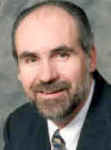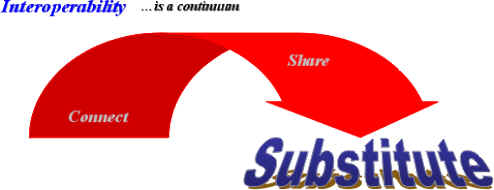AutomatedBuildings.com
Article - Sept 2000
[Home Page] |
[an error occurred while processing this directive]
(Click Message to Learn More) |
|
|

The intent here is to
answer that question with a simpler question "What are you trying to
accomplish, and does one protocol, or more specifically control and
network products based upon it, provide a better solution than the
other? |

John
J. "Jack" McGowan, CEM Hydroscope Inc, USA
Contributing Editor
|
One
of the most challenging decisions facing the controls industry today is what
Building System Network should be the standard for future systems. The debate
is heated between supporters of these networks, or communication protocols.
Making the decision, BACnet™ or LonWorks™, is tough but is it really
necessary to choose one over the other? The intent here is to answer that
question with a simpler question "What are you trying to accomplish, and
does one protocol, or more specifically control and network products based
upon it, provide a better solution than the other?
The DDC industry has been inundated with
information on communication protocols, and vendors are selling complete
automation systems, as well as individual components, and recommending
standardization on one Network or the other. Considering the impact of
networks on a DDC system, it is becoming necessary to understand not only
controls and HVAC, but computer networking and information technology. In
spite of that added demand, real benefits are available, as the evolution of
DDC Network standards presents the opportunity to achieve open systems, and to
leverage off the shelf technology and the worldwide web.
[an error occurred while processing this directive]The
basic requirement for making system communication protocol decisions is the
same as ever: clearly define your expectations. By 1995 when ASHRAE
(American Society of Heating, Refrigeration and Air Conditioning Engineer's)
published BACnet®, there were 100 or more networks and communication
protocols in use throughout the controls industry. Multiple DDC Manufacturers
with multiple generations of products contributed a proliferation of system
networks based on countless proprietary protocols, commonly referred to today
as "legacy systems". System users had long voiced concerns about the
complexity of DDC system management and expansion. This was due to the
inability of systems to share data or communication networks. The industry
became aware of the role that communication played in the long-term success of
DDC systems and the importance of protocols and networking. The same
challenges remain today, but with a tremendous simplification, rather than 100
protocols there are only two, and for now it is simpler to call them both standards.
Both BACnet™ and LonWorks™ are standards of one type or another, but that
doesn't make the choice easier. If one counts legacy systems still in use,
there are more than two networks but it is easier to integrate them than ever
before, and there's less resistance to making legacy source code available to
simplify the task. In the final analysis, establishing system requirements and
choosing between communication options comes down to defining one requirement;
interoperability.
Focusing on interoperability may appear to
sidestep numerous issues being debated in the Network "camps". The
fervor that supporters of each Network demonstrate, and characteristics that
are touted for each makes this issue seem immensely complicated. Set aside
however, questions of who controls the standard, what type of standard it is
and the level at which it operates? Certainly these are important questions,
but the larger concern remains how will the control system be applied, and
what level of interoperability is required? Interoperability in some respects
is an overused and under-defined term. Therefore the focus here will be on
defining interoperability and pointing out how it can be instrumental in
determining system success or failure. Interoperability can be viewed as a
continuum with levels as illustrated below.

At the most basic level, interoperability is
about communication. The two issues that drove standard system communication
were the ability to share data and the ability to replace or substitute
control devices. Sharing data centered on the owners desire to use one
interface (Personal Computer at the time) to access and share data between DDC
systems in one or more buildings. Substitution was based on the desire of
owners to mix and match various manufacturers components in the same system,
sometimes called "plug and play". So the owner considering a new
system must now carefully consider goals and objectives for the system and set
requirements. This makes it possible to choose a network if needed gateways or
other technology used to combine existing equipment with the new system.
The first and simplest level of
interoperability is Connection, and it meets few requirements for most control
systems. At this level controllers can "hang on the same bus", share
the same medium (wire), but there is no interaction between them. It is like
having two separate LANs on the same Ethernet using different application
software that is incompatible. It may be possible to use such an approach to
save wiring costs, but it does not address either of the key drivers that have
been of concern in the control industry.
The second level of interoperability is
Sharing, and it does meet one of the critical needs in the control industry.
This communication level of Interoperability requires that different systems
be connected on the same medium and share data. One of the key benefits
of a network standard is to allow for this sharing of data. This is essential
for many control sequences. BACnet™, in particular, provides more clarity by
defining standard representations for data using object and service data
definitions accepted by the controls industry. It is proposed that at a
minimum the data sharing level of interoperability will be required by most
control applications. This is especially valuable for multi-location users who
do not have significant need for system expansion or "plug and play"
change-outs. In many cases data sharing is at the core of today's meaning of
interoperability. It may be as simple as sharing outdoor air temperature or as
complicated as an OEM chiller controller interacting with a building level
control system to achieve optimization.
The highest level of interoperability,
substitution, has yet to be achieved in the controls industry. It is unlikely
that this type of "plug and play" change-out will ever occur though
there is a movement to standardize control sequences. The key issue here is
that each control manufacturer implements sequences differently. After all
this is the "control industry" and the key differentiator for
companies, what makes them unique, is the quality, sophistication,
optimization and effectiveness of their control sequences. As a result of this
variability, it is not possible to take a VAV box controller from company A
and replace it with one from company B to achieve seamless control. There
could be a host of differences, for example one manufacturer may implement
schedules at an air handler controller and send an occupied/unoccupied signal
to the VAV box, while another may do scheduling at the box. Replacing a
controller that has scheduling embedded with one that waits for an
occupied/unoccupied signal will result in obvious problems. This same scenario
can be identified for every aspect of the control operation, making controller
substitution unworkable today. These issues can be solved on a building wide
basis with explicit specifications by implementing BACnet™ gateways, and
other similar devices, that interpret information and execute control
sequences between dissimilar control architectures.
It appears that the most important trends in
the automation industry revolve around communications and ultimately
interoperability. Enterprise wide interoperability is also a goal, meaning
fire, security, vertical transport, office automation, etc. The best advice
for specifying systems is don't assume anything and be explicit in defining
requirements. Take time to understand and ensure that both networking and
control equipment is compatible, will interact in the manner desired and will
provide data necessary to manage the facility. Remember that interoperability
is a continuum, and don't loose sight of all the old familiar questions about
commissioning, warranty, service and maintenance liability if there are
problems. In spite of the challenges, commissioning with multiple
manufacturers' devices is a reality. At ASHRAE 2000, a BACnet demonstration
over hardwire and a wireless Ethernet backbone included thirty-seven
manufacturers of HVAC, lighting and fire systems.
Standards for Network communication with
automation equipment are here to stay, and of equal interest is that they also
allow access to the worldwide web. Owners are already plugging laptops into a
cell phone to dial up systems. Rapid growth in wireless technology, and the
evolution of web browsers for automation interface is making it easier. At
least three DDC companies have introduced web browser interface software this
year. Owners must still choose the appropriate tool for the job, PC based or
hand held. The old concept of a "person machine interface" or hand
held is evolving, as BACnet® compliant hand helds are now being introduced.
These of course require direct connection to the local network, but it is only
a matter of time before they are wireless and the size of a pocket pager with
multiple lines of display. Just as no one involved in the development of DDC
standard communications could have foreseen how the web would evolve, it
remains to be seem whether or if one of the rival networks will emerge as a
dominant standard.
ABOUT THE AUTHOR
John J. "Jack" McGowan, CEM is Vice
President of Marketing with Hydroscope Integrated Technologies, Inc. and
author of 5 books including "Direct Digital Control" on Fairmont
Press. He was named 1997 "International Energy Professional of the
Year" by the Association of Energy Engineers.
[an error occurred while processing this directive]
[Click Banner To Learn More]
[Home Page] [The
Automator] [About] [Subscribe
] [Contact
Us]


